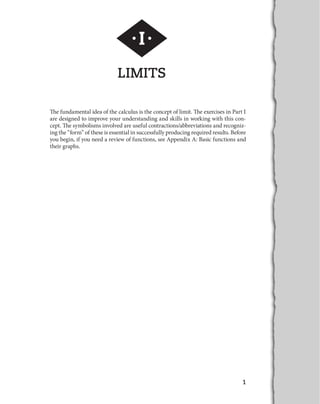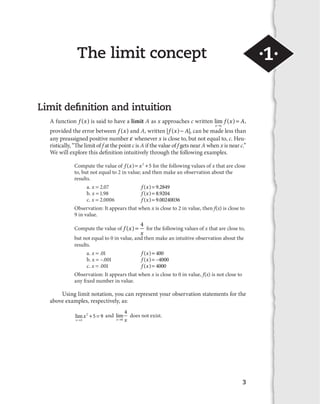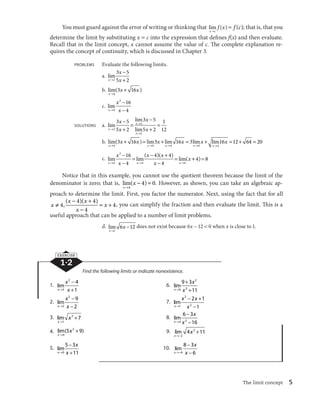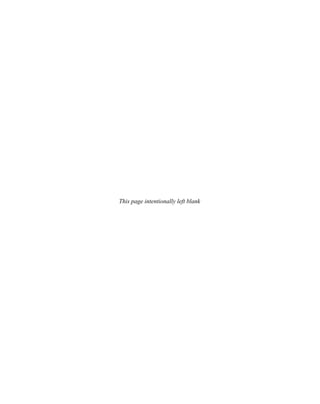This document discusses limits and introduces the concept of the limit. It provides examples to illustrate the definition of a limit and how limits can be used to describe the behavior of a function as the input values get closer to a given number. The key ideas are:
1) A limit describes what number a function approaches as the input gets closer to a given value, without actually reaching it.
2) Basic limit theorems can be used to evaluate limits of sums, differences, products, and quotients if the individual limits exist.
3) Special types of limits include those with a zero denominator or involving infinity in the input or output. These require additional techniques like factoring to evaluate.



![4 Limits
EXERCISE
1·1
Compute the value of f(x) when x has the indicated values given in (a) and (b). For (c), make
an observation based on your results in (a) and (b).
1. f (x) x
x
2
5
a. x 3.001
b. x 2.99
c. Observation? ________________________________________________________
5
4
2. f (x) x
x
a. x 1.002
b. x .993
c. Observation? ________________________________________________________
3. f (x) 3 x2
x
a. x .001
b. x
.001
c. Observation? ________________________________________________________
Properties of limits
Basic theorems that are designed to facilitate work with limits exist, and these theorems are the
“bare bones” ideas you must master to successfully deal with the limit concept. Succinctly, the
most useful of these theorems are the following:
If lim ( )
x c
f x
l
and lim ( )
x c
g x
l
both exist, then
1. The limit of the sum (or difference) is the sum (or difference) of the limits.
f x g x
lim[ ( ) ( )]
x l
c
lim f ( x )
lim g ( x
)
l l
x c x c
2. The limit of the product is the product of the limits.
f x g x
lim[ ( ) ( )]
x l
c
• lim f ( x ) •
lim g ( x
)
l l
x c x c
3. The limit of a quotient is the quotient of the limits provided the denominator limit is not 0.
f x
lim ( )
x c ( )
l g x
lim ( )
x c
lim ( )
x c
f x
g x
l
l
4. If f x f x f x
lim ( ) lim ( ) for n 0
x c
n
x c
( ) q 0, then n
l l
where a is a constant
af x a f x
5. lim ( ) lim ( )
l l
x c x c
§©
6. lim[ ( )] lim ( )
x c x c
n
f x f x n
l l
¶¸
for any positive integer n
7. lim
x c
x c
l
8. lim
1 1 provided c w 0
xlc x c](https://image.slidesharecdn.com/limit-140929031133-phpapp01/85/Limit-4-320.jpg)




![l
is the notation for the left-hand limit of f at c.
. This theorem is a very useful tool
Special limits 9
SOLUTIONS a. lim
x
a
lcx
0 for any constant a
b. lim
x
x
lc
2 c
x
x
c. lim lim
x x
x
x
l
c l
c
3 12
1
3 12
1 1
3 0
1 0
3
d. lim
xl | x
|
c
3
4
3
EXERCISE
2·2
Evaluate the following limits.
1. lim( )
x
x
lc
5
7 6. lim
x
x
2
2 5 6
lc x x
2. lim
7
3
xlc x
7. lim
x
5 3
x x
6 7
6 2
lc x x
5 6 11
3. lim
x
3 x
95 8. lim
l
c
x
4 2
x x x
7 6 3
3 7 5
3
l
c x x
4. lim
x
3 2
x x x
3
47 9
lc x x
18 76 11
9. lim
x
3
x x
2 8 5
lc x
2
3 4
5. lim
8
4
xlc
x
10. lim
5
2 4
xl
cx
Left-hand and right-hand limits
Directional limits are necessary in many applications and we write lim ( )
x c
f x
l to denote the limit
concept as x approaches c through values of x larger than c. This limit is called the right-hand
limit of f at c; and, similarly, lim ( )
x c
f x
Theorem: lim ( )
x c
f x L
l
if and only if lim ( ) lim ( )
f x f x L
l l
x c x c
in evaluating certain limits and in determining whether a limit exists.
PROBLEMS Evaluate the following limits.
a. lim
4
3
xl3 x
b. lim
15
1
xl1
x
c. lim[ ]
x
x
l2
Note: [x] denotes the greatest integer function (See Appendix A)](https://image.slidesharecdn.com/limit-140929031133-phpapp01/85/Limit-9-320.jpg)
![10 Limits
d. lim[ ]
x
x
l2
e. lim[ ]
x
x
l2
SOLUTIONS a. lim
4
3
xl3 x
c
b. lim
15
1
xl1
x
c
c. lim[ ]
x
x
l 2
2
l
2
d. lim[ ]
x
x
1
e. lim[ ]
x
x
l2
l
2
does not exist because lim[ ]
x
x
l
2
2 and lim[ ]
x
x
1, so the right- and
left-hand limits are not equal.
EXERCISE
2·3
Evaluate the following limits if they exist. If a limit does not exist, show why.
l
1. lim [ ]
x
x
4
1 6. lim
x
x
2 9
3
l
x
3
2. lim
x
x
2 4
2
l
x
2
7. lim
7
4
xl4 x
3. lim
4
9
xl8 x
8. lim
x
5 4 8
x x
4
l
x
4
l
4. lim
x
x
0
4 3 9. lim
x
x
2 16
l x
4
4
5. lim[ ]
x
x
l
5
1 10. lim
x
x
2 16
l
x
4
4](https://image.slidesharecdn.com/limit-140929031133-phpapp01/85/Limit-10-320.jpg)

![12 Limits
x x x
SOLUTIONS a. lim lim( ) (lim ) ;
4 7 4 7 4 7 23 thus, the
l l l
x x x
4 4 4
function is continuous at 4.
b. lim( x
) ((lim x
)
)
;
4 4 1 thus, the function is continuous at 3.
l l
x x
3 3
3 x 7 3 x
2 7
19 thus, the function is continuous at 2.
c. lim( ) ( (lim ) ) ;
l l
x 2
x
2
2
d. lim
12
2
xl2 x
does not exist; thus, the function is discontinuous at 2.
e. f x x
2 4
2
x
( )
is discontinuous at 2 because the function is not defined at 2.
However, the limit of f(x) as x approaches 2 is 4, so the limit exists but
lim f ( x ) w
f
( ).
x
l
2
2 If f (2) is now defined to be 4 then the “new” function f(x)
x
x
x
x
2 4
2
2
w
4 2
ª
«
¬
¹
º
»
is continuous at 2. Since the discontinuity at 2 can be “removed,”
then the original function is said to have a removable discontinuity at 2.
EXERCISE
3·1
Show that the following functions are either continuous or discontinuous at the indicated
point.
1. f (x) 5x
7 at x 1 6. g x
x
x
( )
5
5
at x 3
2. f x
x
x
( )
3 8
2
at x 0 7. g x
x
x
( )
5
2
at x 8
3. f x
4
2 x
3
( )
at x 1 8. h(x) 5x2
x 7 at x 5
4. f (x) [x] at x 3 9. f x
x
x
( )
6
2
at x 6
5. g x
x
x
( )
2 6
5
at x 4 10. h x
2 6
x a x
x a
( )
( )
3
at x a
Properties of continuity
The arithmetic properties of continuity follow immediately from the limit properties in Chapter 1.
If f and g are continuous at x c, then the following functions are also continuous at c:
fg
1. Sum and difference: f og
2. Product: fg
3. Scalar multiple: af, for a a real number
4. Quotient: , provided g(c) w 0](https://image.slidesharecdn.com/limit-140929031133-phpapp01/85/Limit-12-320.jpg)
![Further, if g is continuous at c and f is continuous at g(c) then the composite function f C g
defined by ( f C g )(x) f (g(x)) is continuous at c. In limit notation, lim ( ( )) (lim ( ))
f g x f g x
l l
x c x c
f (g(c)). This function composition property is one of the most important results of continuity.
If a function is continuous on the entire real line, the function is everywhere continuous;
that is to say, its graph has no holes, jumps, or gaps in it. The following types of functions are
continuous at every point in their domains:
, provided p(x) and q(x) are polynomials and q(x) w 0
Continuity 13
Constant functions: f(x) k, where k is a constant
Power functions: f (x) xn, where n is a positive integer
Polynomial functions: f ( x ) a x n
a x n
1
ax a n
n
1
1 0 !
Rational functions: f x p x
( ) ( )
q x
( )
Radical functions: f (x) n x , x q 0, n a positive integer
Trigonometric functions: f(x) sinx and f(x) cosx are everywhere continuous; f(x) tan x,
f(x) csc x, f(x) sec x, and f(x) cot x are continuous only wherever they exist.
Logarithm functions: f (x) ln x and f x x b b b ( ) log , 0, w 1
Exponential functions: f (x) ex and f (x) bx,b 0,b w 1
PROBLEM Discuss the continuity of the following function: g(x) 3(sin3x) at a real number c.
SOLUTION 3x is continuous at c and sinx is continuous at all real numbers and so sin(3x) is
continuous at c by the composition property. Finally, 3sin(3x) is continuous at c
by the constant multiple property of continuity.
EXERCISE
3·2
Discuss the continuity of the following functional expressions.
1. f (x) 5( tan3x) at a real number c 6. G x
x x
x
( )
sin
11 2
8 9
on the real line
2. h(x) tanx cos(3x
1) at c 4 7. V(x) sinx cos x on the real line
x
x
3. f x
tan sin
( ) x x x
x
cos
5 3 2
4 3 at c 5 8. T(x) sin2 x cos2 x at c
P
11
4. t(x) cos 5x
3 tanx at c
P
2
9. f x
x
x
( )
tan
sin
at x 2P and at x 6P
5. H(x) 5 8x2
4sinx 13 for x 1 10. g(x) x
15 sinx
10 at x 11
Intermediate Value Theorem (IVT)
The Intermediate Value Theorem states: If f is continuous on the closed interval [a, b] and if
f (a) w f (b), then for every number k between f(a) and f(b) there exists a value x0 in the interval
[a, b] such that f (x ) k 0 .
The Intermediate Value Theorem is a useful tool for showing the existence of zeros of a func-tion.
If a continuous function changes sign on an interval, then this theorem assures you that there](https://image.slidesharecdn.com/limit-140929031133-phpapp01/85/Limit-13-320.jpg)
![must be a point in the interval at which the function takes on the value of 0. It must be noted,
however, that the theorem is an existence theorem and does not locate the point at which the zero
occurs. Finding that point is another problem. The following example will illustrate using the IVT
to determine whether a zero exists and give some insight into finding such a point (or points).
14 Limits
PROBLEM Is there a number in the interval [0, 3] such that f (x) x2
x
2
1?
This question is equivalent to asking whether there is a number in [0, 3] such
that f (x) x2
x
1 0.
SOLUTION The function is continuous on [0, 3], and you can see that f (0) 02
0
1
1
and f (3) 32
3
1 5. Since f (0) 0 and f (3) 0, by the IVT, you know
there must be a number in [0, 3] such that f (x) x2
x
1 0.; that is, there
is a solution to the problem. In this case, a solution can be found by solving
the quadratic equation, x2
x
1 0, to obtain the two roots: 1 o 5
.
2
Approximating these two values gives 1.62 and
0.62, of which only 1.62 is in the
interval [0, 3]. Thus, there does exist a number, namely 1 5
, in the interval
2
[0, 3] such that f 1 5
2
0
¤
¦¥
³
µ´
.
EXERCISE
3·3
For 1–5, use the IVT to determine whether the given function has a zero in the given interval.
Explain your reasoning.
1. f (x) 4x 4
3x3 2x
5 on [
2, 0] 4. g x
x
x
( )
8
3 5
on [10, 12]
2. g(x) 9
x2 on [
2.5, 2] 5. f x
x x
x
( )
3 2
1
on [
2, 2]
3. f x
x
( )
3
4
on [
5, 0]
For 6–10, use the IVT to determine whether a zero exists in the given interval; and, if so, find the zero
(or zeros) in the interval.
6. h(x) x2 5x
2 on [
3, 4] 9. F(x) cos(x) on [5, 8]
7. g x
x
x
( )
3 3
4
on [0, 6] 10. G x
x
x
( )
sin( )
cos( )
§
on
©¨
¶
P P
4 4
¸·
,
8. h(x) sin(x) on [
1, 1]](https://image.slidesharecdn.com/limit-140929031133-phpapp01/85/Limit-14-320.jpg)